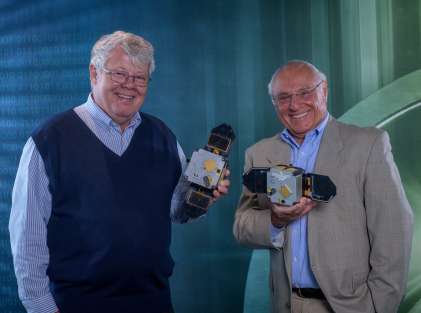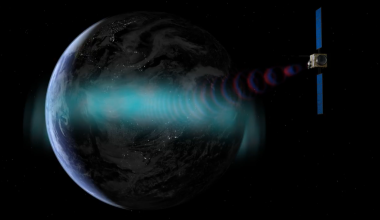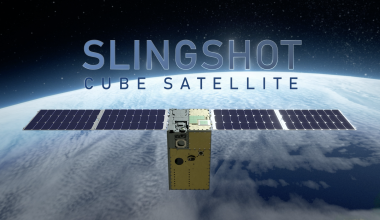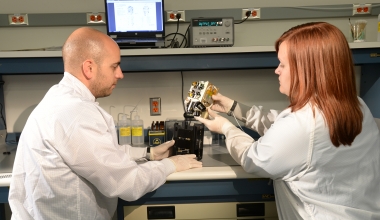In the early 1990s, as the cost of launching spacecraft to low Earth orbit was still extremely high, Aerospace scientists looked to leverage the latest advancements in miniaturization techniques for electronics and mechanical devices to create a vision for small satellites that could provide essential on-orbit capabilities like remote sensing and communication systems at much lower cost.
Using a combination of the corporation’s research and development funds and external grants, Aerospace scientists Ernest Robinson, Dr. Henry Helvajian, and Dr. Siegfried Janson created a community of early adopters, including visionaries in the National Security Space community. One output was the radical concept of the kilogram-mass integrated-silicon nanosatellite formally presented at the 1993 International Astronautics Federation Conference in Graz, Austria. Adoption of the smaller form factor began to grow, gradually at first, but hit an inflection point just a few short years later. Since 1997, nanosatellite launches have doubled roughly every 2.4 years, validating the “nanosatellite revolution.”

In The Nanosatellite Revolution: 30 Years and Continuing, Helvajian and Janson – in collaboration with contributing authors across the planet, including several from Aerospace – document the missions, technologies, policies and future perspectives offered by individuals and organizations that have participated in the nanosatellite revolution.
The book also includes a Foreword by Aerospace President and CEO Steve Isakowitz, who acknowledges the significant impact nanosatellites have had in shaping the transformed space domain today, enabling countless innovations and serving as an accessible entry point for researchers, entrepreneurs, students, and others to begin experimenting with satellites of their own.
We had a chance to interview Helvajian and Janson to learn more about the book and get more of their insights about the history and potential future of nanosatellites.
Q: This book is actually a follow-up to the highly regarded Small Satellites: Past, Present, and Future, which was published in 2009 by The Aerospace Press. How does The Nanosatellite Revolution build on that work?
Yes, this book is actually the fifth in the series dating back to 1995. The 2009 book was an introduction to small satellite history, available technologies, spacecraft, programs, and missions. The last two chapters (one by Janson and one by Helvajian) looked at the future of small satellites and potential fabrication techniques. Our new book updates and expands on these topics. We have an historical chapter on Russian small satellites for science missions, two chapters on marine traffic monitoring using CubeSats, and four chapters on interplanetary small spacecraft. We have authors from four NASA centers, DARPA, international universities, and of course, Aerospace. Moreover, we have chapters that deal with the space debris problem and space policy issues.

Q: To your point, Nanosatellite Revolution covers a breadth of topics across 26 chapters. What was your approach in developing the book and what do you hope readers will get out of it?
The book is less about how to build a nanosatellite but rather provide to the audience mission examples of what worked and what did not. Also, we wanted to fill in some missing pieces from the previous book, like including more NASA programs, expand our international authorship, and provide a current update on nanosatellite technologies. After an internal down-select of possible authors and missions, we sent out chapter requests to a broad group of selected experts. Fortunately, we received more than enough content for this book. We hope that it provides a snapshot of nanosatellite technologies as of roughly 2020 and stimulates more advancements. The epilogue at the end (by Janson and Helvajian) puts to paper our views of the possible “next steps” in the foreseeable future.
Q: It’s evident the tremendous amount of collaboration that went into this effort. Can you talk about your experience in deciding what information to include? What it was like working with the contributing authors to ensure they’re properly represented in the book?
This is an 800-page book, and the original manuscripts would have boosted the page count significantly. We pointed out redundant text and asked authors to provide more compact manuscripts. Many figures and tables also required modifications to quickly convey the desired information without confusion. Each author got the revised manuscript of their chapter for final review.
Q: Regarding the trajectory of nanosatellite adoption, are there any key watershed milestones that helped to cement this technology as a viable option for space mission needs?
One major milestone was the development of the CubeSat standard. This enabled a containerized satellite approach that was relatively launch-vehicle agnostic. Design/build/fly/get flight data timelines shrank from about seven years using legacy launch systems and satellite designs, to one year. The CubeSat approach also allowed a ~1-kg mass spacecraft to be launched for $40,000 to $100,000. This allowed universities, small companies, and even individuals to get their own spacecraft flown.
A second milestone was the demonstration by the startup company, Planet Labs, that a space mission –a constellation of nanosatellites for Earth observation – can actually be profitable.
Q: What are some current examples of how nanosatellites are continuing to support our understanding of space? Are there any missions or programs today that readers can look to?
The book identifies many missions where nanosatellites have provided a better understanding of space and Earth. Conducting biological cell testing in near Earth environments. Missions such as Automatic Identification System (AIS) for tracking marine and air traffic. Sub millimeter remote sensing that can penetrate clouds to taking pictures of Mars as the hosted vehicle in a flagship NASA/Mars mission.

Q: Miniaturization is a trend that has been fundamental to nanosatellites. What are some new innovations in this area that excites you?
Space-to-ground optical communications from CubeSats, pioneered by Aerospace under NASA funding, enables transmission of gigabytes of data from a low Earth orbit CubeSat during a single ground station overflight. Use of hundreds-to-thousands of nanospacecraft, either as a formation flying cluster or a physically-connected assembly, can provide new mission opportunities based on variable spacecraft configuration and deaggregation.
Q: Are there any other emerging technologies or capabilities that could potentially enable major breakthroughs in this area for the future?
Propulsion provides improved orbit insertion, maintenance, and de-orbit options, and reaction wheel desaturation outside of LEO. It is required in geosynchronous Earth orbit, cislunar, and interplanetary space, and may be required in the future for space traffic management in LEO. Another area is miniaturized radioisotope powered sources that could provide electrical power without the need of solar panels, opening routine NASA missions for solar system exploration with nanosatellite probes.
Q: The book also digs into impending issues spawned by the nanosatellite revolution, such as a rapid increase in the orbital debris environment. Have these issues impacted how nanosatellites are planned to be used?
Yes, but the “super-microsatellites” used by the thousands in dense LEO communications constellations, like StarLink, are the fastest-growing component in LEO. These spacecraft have active propulsive deorbit, and more nanosatellites should include this option. An additional option for altitudes below ~700 km to avoid collision with another space object is active attitude control; a nanosatellite can be switched from a modest drag attitude to either a low or high drag mode to prevent a collision a week or more in the future. Improved space tracking to reduce positional error bars from hundreds of meters to meters, will enable a significant reduction in false collision predictions, and drag-based collision avoidance.
Q: Do you have any closing thoughts you’d like to share with our readers?
Enjoy the book! Read the epilogue. This book would have come out in 2020 or 2021 if the world didn’t have to suffer through COVID-19. This probably will be our last book (Janson has already retired), so we stop at Vol. 5 as editors.
Q: Where can Aerospace employees or other interested readers obtain a copy of the book?
It is directly available from the SPIE in hardcover or PDF.
Aerospace flew the world's first containerized spacecraft in 2000, and has since delivered about 40 spacecraft to date, operating the world’s largest fleet of experimental CubeSats. Even today, we continue to pioneer new innovations for the field of small satellites, including for CubeSats, nanosatellites and other bold concepts. Aerospace established iLab and xLab to accelerate the exploration and prototyping of new capabilities for space. We encourage you to learn more about our work in Small Satellites.









